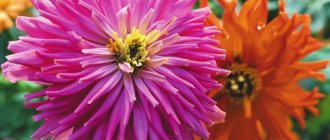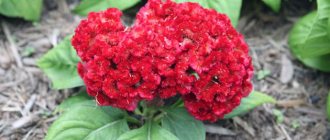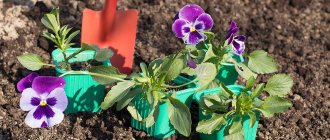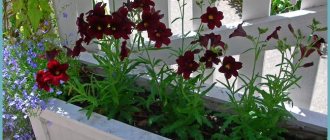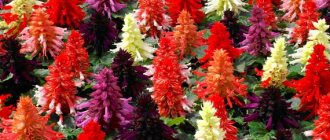Description of Kobei
Kobeya is an ornamental vine. Its homeland is Mexico and Peru, where it blooms almost all year round as a perennial and serves as decoration for facades and gazebos. In Russia, the flower is considered an annual, since it is not able to survive the winter even in the southern regions, unless we are talking about greenhouse cultivation.
In our country, only one variety of kobei has taken root - climbing.
Under favorable conditions, its shoots can reach 7 meters in length, but the average is 4 meters. Leaves are oval shaped. In summer they are green, but when it gets colder they change color to red-violet. Therefore, even in the absence of flowering, kobeya looks quite attractive at the end of the season.
In mid-summer, cup-shaped buds appear on the vine. Their diameter is 7-8 cm. The color of the petals can be white, lilac (purple) or pink. After flowering is completed, green, egg-shaped fruits are formed.
Interesting! Experienced flower growers note that white kobeya is the most capricious variety of flower.
In some growing regions it is not possible to wait for them, since frosts occur quite early.
Answers to frequently asked questions when growing kobei
To grow a beautiful, long-flowering plant, it is important to follow agrotechnical rules and listen to the advice of professionals. If you make serious mistakes, the plant will grow weak, flowering will not last long, and various diseases may also develop.
What soil should I buy for growing seedlings?
When growing seedlings, you can purchase ready-made nutrient soil with neutral acidity or prepare it yourself. The plant grows and develops well in soil that contains a large amount of organic matter (peat or humus). Also, to prepare nutritious soil, light turf soil and leaf humus are mixed. To ensure that the prepared soil is airy and water-permeable, river sand, vermiculite or perlite can be added to the finished substrate.
How can you stimulate seeds for further growth?
For rapid germination, experienced gardeners recommend soaking the seeds for 48 hours in Epin or using traditional methods. Such as:
- boric acid - dilution of 2 g per 1 liter of water. The seeds are soaked for 2-3 hours;
- mushroom broth - 100 g of chopped dried mushrooms, pour 1 liter of boiling water. The decoction is infused for 24 hours, the seeds are kept for at least 6 hours;
- aloe juice – the juice is mixed with water (1:1), the seeds are kept for 24 hours;
- honey – 1 tsp. for 250 ml of warm water. The seeds are kept in the honey solution for no more than 6 hours.
Why don't the seeds germinate?
The germination rate of climbing kobei seeds is 30%. Therefore, when sowing seeds, planting material is calculated as follows: to obtain one plant, 3-4 seeds are planted. This is due to the fact that the seed shell is very dense and the sprout will not hatch without preliminary preparation.
Why are seeds soaked?
Soaking seeds before planting increases germination. To do this, you can use warm, settled water, aloe juice, honey or biological products. During germination, seed material is often covered with mucus, which must be carefully removed with gauze or soft cloth.
How to harden kobe seedlings
In order for the kobe to quickly adapt to a new place, it must be hardened. To do this, the young plant is placed on a glazed balcony or under an open window. The time spent outdoors is increased daily. After 3 weeks of hardening, the seedlings are ready for transplanting into open ground.
What to do if kobei seedlings do not grow?
If the kobei seedlings grow poorly, it means that the container for planting was chosen incorrectly. In shallow containers, the plant does not have enough space to grow its root system. As a result, the young vine develops poorly and stops growing.
Briefly about the features of growing kobei in the table
The table below gives a brief description of the kobeya regarding its planting and care.
| Landing | Seeds: end of February. Seedlings: late May-early June. |
| Soil requirements | Sufficiently fertilized, fertile land. |
| Lighting | Kobeya needs good lighting; slight natural shading of the plantings is allowed. |
| Garter | Not required, the climbing plant tenaciously clings to the support. |
| Bloom | From the second half of summer until the onset of the first frost. |
| Watering | It is unacceptable for the soil to dry out completely; watering should be moderate, but quite frequent, especially in hot weather. |
| Reproduction | Using cuttings and seeds. |
| Feeding | Nitrogen during the period of shoot growth, potassium and phosphorus at the stage of bud formation. |
| Pests | Affected by aphids and spider mites. |
| Diseases | Gray and root rot. |
| Growing regions | Central and Northwestern regions, Southern and Middle Urals, Siberia (regions with a temperate climate). |
Features of Kobei
This plant is fast growing. In this regard, its branched root system is very strong and has many thin fibrous roots. The length of the shoots can reach up to 6 meters and even in some cases much more. The composition of the alternately arranged complex pinnate spectacular leaf plates includes only 3 lobes. At the tips of the stems, the leaves change and become branched tendrils, which help the shrub to climb up the support, clinging to it with their help. The large flowers are bell-shaped and reach a diameter of 8 centimeters; their pistil and stamens are protruding. The flowers have long pedicels and grow from the leaf axils in groups of 2 or 3 or arranged singly. When the flowers just begin to open, they are yellowish-green. And after full opening, the flowers change their color to white or purple. The fruit is a leathery capsule that opens at the side seams. Inside it are large, flat, oval-shaped seeds.
Kobeya: planting and care
Sowing and planting kobei according to the Lunar calendar for 2021
Kobeya is grown through seedlings, as it takes a long time to germinate. Some gardeners recommend starting sowing seeds at the end of January. Grown seedlings can be planted in the ground when the threat of frost has passed. As a rule, this is the end of May - beginning of June. Sometimes folk signs can come to the rescue, for example, if it’s cold on March 21, then you should wait a little while planting the kobeya in the ground, as this indicates that the warmth will not come soon.
The table shows favorable dates for sowing and planting kobei in 2021:
| Month | Sowing seeds | Picking seedlings | Transplanting |
| January | 23-25, 30, 31 | – | – |
| February | 3-5, 7-9, 19-24 | – | – |
| March | 14-21, 26-28 | 1-4, 7-9, 30, 31 | – |
| April | – | 15, 16, 22-25 | – |
| May | – | 2-5 | 7-9, 13-15 (only in the south), 28, 29 |
| June | – | – | 9, 16-18, 20-22, 28-31 |
Planting climbing kobei with seeds step by step
Planting kobea seeds is labor-intensive work, but not difficult. The guarantee of a positive result directly depends on compliance with the rules of planting and growing:
- A 3 cm layer of drainage is poured onto the bottom of the cups.
- The container is filled with nutrient soil with neutral acidity.
- To avoid picking, the seeds are laid out on the flat side in separate cups on moist soil and sprinkled with a 1-1.5 cm layer of soil.
- A peg is stuck next to the planted seed so that the grown seedlings can grow.
- The top layer is sprayed with warm water.
- Cover the container with glass or plastic wrap and put it in a warm, well-lit place.
- To prevent fungus from appearing on the ground, the microgreenhouse is ventilated daily for 20-30 minutes.
- Moisten the substrate as it dries.
- After the appearance of 2 true leaves, the seedlings are transplanted by transferring them into a larger container. To develop a strong root system, the pot should have a volume of 2-3 liters.
Growing kobeya from seeds at home
When growing from seeds, the key to obtaining healthy seedlings is the choice of high-quality seed material. It is advisable to purchase it from reliable manufacturers. But even in this case, you need to be prepared for the fact that the germination rate of kobei almost never reaches 100%. Therefore, seeds must be purchased in reserve. The cost of one bag varies from 35 to 60 rubles, depending on the variety and manufacturer.
Sowing kobei for seedlings
Germination takes quite a long time, from the moment of sowing to the appearance of shoots it takes about 3 months. Therefore, kobeya is sown at the end of February or at the beginning of March. On some forums you can find information that you can start sowing at the end of January. A wooden box is suitable as a container, and it is better to buy specialized soil that contains a sufficient amount of fertilizers necessary for the plant.
If you use your own soil, it must be calcined or disinfected with a solution of potassium permanganate. It is recommended to pre-germinate seeds for planting. To do this, they are placed in a deep plate on a damp napkin or in a glass with a small amount of water, without touching each other. The top of the container is covered with film.
Some experts recommend carefully piercing them after swelling. In addition, a mucous coating may appear on their surface, which will need to be removed. All these measures will allow the sprout to emerge faster. Sprouted seeds need to be planted to a depth of 15 mm: they are laid out on top of the ground and sprinkled with nutritious soil on top.
Many gardeners prefer another method of germinating seeds and purchase special peat tablets. After getting wet, they increase significantly in volume and soften slightly, so the seeds are simply gently pressed inside.
Containers with seeds are placed in a well-lit, warm place. This could be a window sill, but then it is necessary to exclude drafts. If you use dry seeds, the first sprouts will appear within 2-3 weeks, the germinated material will sprout a little faster.
To summarize, the step-by-step scheme for planting seeds is as follows:
- Germination or planting seeds in a peat tablet.
- Planting in a container.
- Topping
- Hardening.
Caring for kobei seedlings
As soon as 2 full-fledged leaves are formed on the shoots, the kobeya is dived. Together with a lump of earth, it is transplanted into a pot with a volume of at least 3 liters. This will allow strong roots to form.
To create a support, you need to stick a small arch or ladder into the pot. And three weeks before planting in the ground, it is advisable to begin the procedure of hardening the seedlings. To do this, it is placed in a cooler place, for example, on an insulated veranda or balcony. If there are other flowers or seedlings nearby on the windowsill, then it is important to ensure that the loach does not entwine them with its mustache.
If the shoots have reached too large a size, and the time for planting them in fresh air has not yet come, then you can lightly pinch the stem.
How to properly plant climbing kobeya for seedlings: stages and diagrams
The procedure for proper planting involves not only the procedure itself, but also preparatory measures. Each of the events has its own subtleties.
Which container to choose
Kobeya does not tolerate regular transplanting and picking, which can injure its root system.
Therefore, you need to immediately plant the seeds in individual containers, cups or pots. Thanks to this, you can pick up plants using the transshipment method without destroying the earthen ball or injuring the roots. The suitable diameter and height of the container is about 10 centimeters.
Important! There should be drainage holes at the bottom of any container (with the exception of peat products, as they already allow moisture to pass through very well).
How to prepare the soil mixture
In terms of soil preparation, everything is very simple. Nutritious, loose, light, moisture-absorbing, air- and water-permeable soil is suitable. You can buy a universal soil mixture for flower seedlings.
You can also prepare the soil yourself. To do this, mix lowland peat (2 parts) + humus (1 part) + sand (1 part) + garden soil (1 part). If you don't want to add soil from the garden to the mixture, you can simply use three parts of peat.
How to prepare seeds
After sowing, kobei seeds germinate for quite a long time, after about 2-3 weeks.
To make seedlings faster, more friendly and stronger, you can prepare the seeds by soaking them in a growth stimulator according to the instructions (for example, Epin, Zircon). After processing, they must be sown immediately.
To get seedlings earlier, you can germinate the kobe seeds before they hatch (this will take about two weeks). To germinate, you need to wrap the seed in cotton cloth (the seeds should not touch each other), moisten it with clean water, wrap it in a plastic bag and put it in a warm place (at about +23-26°C). Before pecking, you need to regularly check the seeds and, if necessary, moisten the fabric (it should not dry out). During this time, it is recommended to change the fabric with a new one every few days and wash the seeds with clean water to prevent mold. If the seeds become moldy, you must immediately wash them carefully and place them in a new cloth. It should be planted in the soil immediately after hatching. Seeds that do not hatch within 14 days can be safely discarded.
Kobe planting scheme
Step-by-step instructions for planting climbing kobei seedlings at home:
- Place perlite or broken bricks (about 2 cm thick) on the bottom of the container; they will act as a drainage layer.
- Fill the containers with soil, leaving a short distance to the edges.
- Moisten the soil with a spray bottle with warm water.
- Make a hole in the center of the cup, 1.5 centimeters deep.
- Carefully place the seed into the hole (it should be horizontal, flat side down).
- Cover the hole with a layer of soil so that the hole is level with the surface of the earth.
- Moisten generously with a spray bottle.
- Cover each glass or pot with a covering material (film, glass, lid) to create a mini-greenhouse.
Planting kobei in open ground
Next, let's talk about planting and care in open ground. The general condition of the seedlings in the future depends on the correct planting of kobei.
Landing dates
Kobeya can be planted in open ground in consistently warm weather, which prevents the occurrence of night frosts. Even a slight and short-term cold snap can lead to the death of plantings.
In central Russia, this planting period occurs at the end of May or beginning of June. But there is also no need to delay the deadlines, otherwise the process will become much more complicated, the shoots will be difficult to separate from the support, and the risk of their damage increases.
Selecting a location
Kobes love well-lit areas, but at first it is advisable to slightly shade the plantings. Flowers develop well under a small canopy.
They grow best on fertile soil, so you should take care of preparing the flowerbed in the fall by adding humus, peat and superphosphates. Be sure to provide drainage - kobes love loose soil with good permeability. You should not plant them where water regularly stagnates.
Important! Experienced flower growers note that the color of kobei buds can be affected by the acidity of the soil: if it is increased, the color will be brighter; if it is decreased, blue and bluish shades will predominate.
Planting kobei
The seedlings are carefully transferred to previously prepared holes and sprinkled with nutritious soil mixture. The shoots are carefully straightened and placed on a support. It is best to use a ladder or mesh for these purposes. But some people prefer to form an arch out of loaches.
The distance between the bushes must be at least 70 cm, otherwise they will intertwine with each other as they grow.
If you do not carry out the hardening procedure in advance, the adaptation period will be delayed, the leaves and shoots may turn white under the sun.
How to determine the time of sowing of climbing kobei?
The timing of sowing seeds for seedlings depends on the region of growth. The whole process is long and labor-intensive. When sowing seeds, it is important to take into account that 3 days should be allocated for preparing the seed and 15 days for germination.
Seedlings are planted in open ground after the end of night frosts and at a daytime temperature of +10-15°C. But since the weather is often changeable, young seedlings are covered with agrofibre.
Kobei care
Caring for a kobei is quite simple. You just need to carry out timely watering and periodically apply fertilizers. Flower growers recommend fertilizing every two weeks to get abundant flowering. To do this, you can use specialized preparations or potassium-phosphorus fertilizers.
Watering should be fairly frequent, especially in hot weather. The soil should not stand dry for a long time, otherwise the leaves will begin to wither and turn yellow. Drafts may also be the reason for this.
At first, young plantings must be protected from the scorching sun using a canopy. If the kobeya is part of the landscape design and is planted in a flowerpot or flowerpot in the garden or country house, then it must have a drainage layer. To create it, expanded clay or fine crushed stone is suitable, which is laid out on the bottom of the container. Such a loose cushion will improve aeration and also accelerate the absorption of nutrients from the soil by the roots.
To stimulate growth and flowering, it is recommended to remove faded buds and damaged parts of shoots every two days.
The plant does not require additional tying; it is a creeping plant and clings to the support itself with the help of antennae, the installation of which must be thought out in advance. Some gardeners initially plant kobeya near the walls of the veranda or gazebo. But even at home it looks quite beautiful when it weaves around the balcony. True, indoor vines often sneak into neighboring properties, so it’s better to think through this moment in advance. Judging by the reviews, the wall itself under the vine does not get wet, does not turn black or collapse, as can happen when planting denser and more lush vines.
How and when to plant kobe seedlings
Thanks to competent picking, kobei seedlings will be able to grow a well-developed, strong root system. And by the time it is planted in open ground, the plant will be very strong, will be able to quickly adapt to a new place and begin to grow, entwining the support.
When can you pick kobeya at home? Standard picking time: when 2-3 true leaves appear.
It is very important to choose the right container: at this stage you need to choose large pots of about 3 liters . The soil suitable is the same as for sowing.
It is necessary to plant kobei seedlings according to the following scheme:
- 3-5 hours before the procedure, you need to water the plants moderately.
- Fill new containers with soil.
- Carefully pick up the earthen ball of seedlings without destroying it, and replant the plants using the transshipment method.
- Fill in the voids in the pot and lightly compact the soil.
- Water thoroughly. If the soil settles after this, fill it up to the previous level.
The first few days after the procedure it is very important to shade the plants from direct sunlight . Bright lighting can have a negative impact on weakened, stressed plants.
Important! Do not forget that kobeya is a climbing annual. a temporary support next to the plant so that the plant can curl around it before transplanting into open ground. For example, you can buy a special support for indoor flowers or build it yourself.
Propagation of kobei by cuttings
We offer step-by-step instructions for the process of cutting kobei:
- In spring or August, a cutting about 10-15 cm high is cut under the node.
- Take a glass of warm water (+25 °C).
- The top of the container is covered with a film in which a small cut is made.
- A cutting is inserted into the cut.
- The glass from the cuttings is placed in a well-lit, warm place where there are no drafts.
- After the root appears, you can transplant the plants into a pot of soil.
Some gardeners plant cuttings directly into the ground. In this case, it is very important that it contains a large amount of nutrients.
Kobea cuttings
Kobeya rooted in this way blooms much faster than its counterparts obtained from seeds.
How to prepare planting material for sowing
Kobe seeds have a dense shell and very low germination rate, so preparatory work must be done before planting. For this:
- The seeds are laid out in a shallow, wide container at a distance of 2 cm and filled with warm water.
- To prevent the liquid from evaporating, cover the seed with gauze or a paper napkin.
- After 2 days, carefully remove the dense shell, being careful not to damage the internal contents.
- After cleaning, the seeds are treated in a weak solution of potassium permanganate to disinfect and prevent the occurrence of fungal diseases.
- After thorough drying, the seeds are transferred to a plastic bag and stored in a dry, sunny place. To prevent the seeds from scorching and causing mold to appear, the bag must be open.
- If the temperature and humidity conditions are maintained, the seeds will germinate in 14 days.
IMPORTANT! For rapid germination, the seeds are kept in a growth stimulator for 4 hours.
Pests and diseases of kobei
Kobeya quite steadfastly endures the attack of various pathogenic microorganisms, which are characteristic of most vines, but often becomes prey for spider mites or aphids.
Spider mite
Parasites can be detected visually by curled leaf blades. Treatment must be started immediately, before the problem and its consequences become irreversible.
- Treating flowers with an acaricide (Fitoverm, Kleschevit, Iskra) will help get rid of mites.
- The destruction of aphids is carried out with insecticides (Aktara, Tanrek, Apache, Konfidor).
All drugs used are diluted strictly according to the instructions; spraying is carried out in dry, windless weather.
Preparing seeds for sowing
The perennial does not withstand the frosts of our climate, so it is grown as an annual. For this purpose, seedlings are sown every year. The process becomes more complicated due to the structure of the fruit. Dicotyledonous seeds are covered with a shell, which makes germination difficult. It must be dissolved in water, where after some time the shell of the fruit takes on the appearance of mucus. The process can be described as follows:
- Place the seeds on damp gauze so that they do not touch each other.
- Cover with plastic wrap.
- Place in a warm place, it lasts for several days.
The seed material is placed in damp gauze and then placed where it is warm to quickly remove the shell. To avoid drying out, you need to add water from time to time. After some time, the fruits become covered with mucus, which must be removed by hand. It is difficult to completely expose it in one go; you have to repeat it again until cleansed.
This is important for germination; sprouts will appear in ten days. If the shell remains, the process will be long, about a month. If mold appears, you need to treat it with a solution of potassium permanganate.
Important! To germinate seedlings, it is better if the soil is dry on top and moist inside.
Is it possible to preserve kobeya in winter?
Kobei definitely cannot survive wintering in the open ground in our country. But it is possible to save the plant until the next season; https://mrdachnik.com advises for this:
Cut off all shoots at a distance of 15 cm from the ground, carefully dig the plant out of the soil and transplant it into a pot. Place in a cool room. Ideally, the house has a naturally lit basement where the temperature in winter is +5 °C. Watering during this period is reduced to a minimum. With the onset of spring, the plant needs to be transplanted into new soil, and the frequency of watering should be resumed.
Features of care
Kobeya should be watered systematically, and during a long dry period, watering should be more abundant. But it must be taken into account that if the liquid stagnates in the roots, this will provoke the development of rot. You need to be especially careful when watering if the shrub grows in a shaded place.
At the beginning of active growth, such a plant needs frequent feeding, which is carried out once a week, and for this it is recommended to use nitrogen-containing fertilizers. During budding, kobeya will need potassium and phosphorus. They begin to feed the plant almost immediately after the seedlings appear. Then when the plant’s first leaf forms, it will need to be fed with humate. After this, the kobeya is fed alternately with mineral fertilizers (for example, Kemira) and organic matter (mullein infusion) until the very beginning of flowering. In order for the vine to develop and grow normally, you need to systematically loosen the soil surface and pull out weeds.
How to propagate
As mentioned above, kobeya can be grown from seed, and it can also be propagated by cuttings. Cuttings are taken from mother bushes, which must remain indoors all winter. When active growth of young shoots begins in spring, some of them can be cut off and stuck into moistened sand for rooting. The rooted cuttings should be transplanted into open soil in the last days of May or the first days of June. Such plants begin to bloom somewhat faster than those grown from seed, but at the same time their flowering is not lush and not so beautiful.
Pests and diseases
Aphids and mites can settle on the plant. To get rid of such insects, it is necessary to treat the plant with a solution consisting of phytoverm and potassium green soap. Instead of green soap, you can take flea shampoo for animals (it is also used to control other pests).
Growing kobei forum, reviews
– It is very difficult to grow seedlings from seeds. Many don't sprout. I tried material from different manufacturers, germination was poor. Only after I started looking at the packaging times did everything fall into place. After lying in the ground for the required time, they sprouted.
– Liana is simply beautiful. I grow it on the loggia. Every year it blooms from the end of July to the end of September. I keep an eye on the soil moisture, as taught.
– I tried to grow a new plant because I liked the reviews about it. Everyone really liked the result. Liana braided the entire arbor. And when the flowers appeared, there was no end to the delight. No one knows what it took to germinate seeds or grow seedlings.
Important! By vegetative means, kobei propagation occurs during the growth of shoots at the overwintered root. This method is called cuttings
Care
Because this plant grows quickly, it requires large amounts of nutrients. You need to start feeding kobeya two weeks after planting. During this time, the culture takes root and begins to grow rapidly.
Fertilizers with a predominance of nitrogen are required for fertilizing in the first month, since the green mass of shoots and leaves increases. And when the buds begin to appear, it is better to choose fertilizers with more phosphorus and potassium, they help the plant during flowering.
The vine should be watered sparingly throughout the season, except on very hot and dry days. At this time, the amount of water is increased, but care must be taken to ensure that there is no excess moisture.
The climbing plant practically does not need pruning and shaping, but dried flowers can be removed so that the plant does not waste energy on producing seeds. You also need to make sure that the vine does not entangle its neighbors growing next to it.
Aphids and spider mites can cause great harm to this vine. When aphids appear, the plant is treated with Fufanon, Actellik, Aktara or Bankop. Spraying is carried out at intervals of 2-4 weeks.
Spider mite
Spider mites are a very dangerous pest, after the attack of which plants are quickly depleted. This pest most often appears during hot and dry periods. To prevent spider mites, plants need to be showered frequently and the soil should not be allowed to dry out. When this insect appears, the plants are treated with Aktelik, Fitoferm, and Neoron. Usually two treatments are carried out.
With the onset of late autumn (before the first frost), the shoots of the kobei bush are cut off at a level of half a meter from the surface of the ground, and the highly branched root with a small lump of earth is carefully dug up and placed for storage in a cool, dry room with a temperature of 5 to 7 degrees. During the winter period, the bushes are regularly inspected and slightly moistened so that they do not dry out too much.
In the spring, when the last frost has not yet passed, the plants can be planted in large containers with soil and started to germinate in a bright room. And when the time comes for planting in open ground (May - June, depending on the region), the plants will already have grown shoots.
When transplanting from a container into the ground, you need to preserve the earthen ball with roots. At the end of it, the bush is watered with a large amount of water, and then with a solution of “Kornevin” or another stimulant, which helps the formation of small white absorbing roots.
It will be useful to read:
Petunia is one of the most popular flowers, attractive and quite unpretentious. They look very impressive...
Planting seeds in the ground
The young Kobei should “move” to open ground at the beginning of summer or in the last days of May, after the thermometer at night stops dropping below 5 degrees and the sun shines abundantly.
To ensure that the kobei remains comfortable at all times, it is necessary to select those areas of land that receive a sufficient amount of sunlight. The soil is fertile and there are no drafts.
An abundant amount of sunlight and energy throughout the day contributes to the especially beautiful, long-lasting flowering of bell-shaped inflorescences of lilac, yellow, and light green colors.
A “vinaigrette” is placed in small recesses, which consists of loose peat, humus and turf. From the container, kobei seedlings together with a piece of soil are placed in holes, sprinkled with soil and watered generously. Kobei are transplanted into open soil at a meter distance between themselves and other representatives of the plant world. Supports are required for seedlings, or plants are planted near arches, fences, house walls, gazebos, and so on.
A grown kobeya needs regular watering, removal of all weeds, loosening the soil, weekly constant feeding with preparations containing nitrogen, phosphorus and potassium fertilizers, which occurs every week.
Planting rules: 1. Grown vines must be planted at a 2-meter distance from each other. 2. Before planting, loosen the soil and add humus, ash, and peat to the hole in a ratio of 2:1:2. 3. After planting, sprinkle the seedlings with soil and water well with warm water. 4. Cover the area around the seedling with hay and sawdust.
Types, varieties and photographs of kobei
Nine species of plants are known to grow in natural conditions, but only one of them is grown in garden and home conditions - climbing kobeya.
It is also called creeping ivy, climbing ivy, Mexican ivy and monastery bells. It forms many shoots up to four meters in length. The pinnate foliage is slightly wrinkled and lacy, with branched tendrils at its ends. Large buds of climbing kobei, when blooming, have a greenish color and a musky aroma. As they grow, they turn lilac and then dark purple and take on a honey-like scent. In addition to the purple kobeya, a garden variety with white flowers called Alba has been bred.
How to grow kobeya from seeds on the balcony
The flower is also grown on the balcony, it looks very impressive and protects from the sun. You can grow a vine at home in the same way as in an open garden. Before planting, you need to remove the seed material from the shells for better germination. Then prepare the soil for planting. Peat or coconut substrate is ideal.
It is better to take a large container for planting, because the flower has a developed root system. And due to the fact that transplantation is poorly tolerated, it is better to plant sprouted seeds in a permanent place of residence, in a flowerpot or box.
As the lashes stretch, they need to change their support so that the stems do not intertwine. The tropical resident requires abundant watering and constant feeding. The soil needs to be fertile and loose. This will be the key to abundant flowering. Kobeya will braid the balcony and protect it from the sun's rays.
Care after flowering, kobeya in winter
After the plant begins to fade, which happens towards the end of September, all shoots are pruned. After which the flower is dug up with a lump of earth, placed in a box with sand, which must be moved to the cellar. Anyone who grows dahlias, clematis, and other flowers knows how to do this. The stems are cut, the root with a lump of earth is dug up, and stored.
But wintering vines is a little different. Its root must be watered from time to time, preventing the soil from drying out. Closer to spring, you need to move the flowerpot with the vine closer to warmth and light, and increase watering. By the time of planting, the plant will sprout and flowering will occur earlier.
You can take cuttings from such a plant for propagation; this method speeds up flowering. Although gardeners practice growing climbing kobei from seeds much more often.
Possible problems during cultivation, diseases and pests (treatment)
The main problems when growing kobea are that there is no flowering. This problem occurs when air humidity drops to a minimum. Due to the fact that the liana is a tropical plant, it needs a humid climate, as well as sun and warmth. A shaded location will have a negative effect on flowering. The liana will weave everything, but it will bloom sparingly. Air humidity at high temperatures will help it bloom. You need to water with a hose, sparing no water, but make sure that there is no waterlogging.
Important! For flowering, it is necessary to fertilize with potassium-phosphorus fertilizers once every two weeks.
In addition, the difficulty in growing is based on the fact that the kobe seed material germinates only in the first year after packaging. And the shelf life is three years. Therefore, when purchasing, germination may be zero. Without treatment, they need twenty days to germinate. Only then can we say that the seeds are gone.
Kobeya suffers from root rot, which occurs from excessive watering. To avoid this, watering is reduced, the bushes are treated with a soap solution, and the holes are sprinkled with ash. The plant is affected by the following pests:
- spider mite,
- aphid.
The foliage becomes dull, cobwebs appear, and the flowers fall off. If pests cannot be detected, the plant will have to be removed and burned. If this is done at an early stage, then you can limit yourself to destroying part of the plant. You need to treat it with laundry soap and purchase special insecticides to consolidate the result.
Features of reproduction
There are several ways to propagate kobei: seeds, cuttings, layering. In our conditions, as a rule, the first one is practiced.
It is not possible to plant vine seeds directly into the ground in areas with a temperate climate. To grow kobei in the Moscow region, the seedling method is used. Seeds are germinated indoors in individual containers with soil; as soon as warm weather sets in, the seedlings are transferred to open ground to a permanent place.
To propagate kobei, strong young shoots are cut from cuttings from plants that have spent the winter in containers. The cuttings should be about 20 cm long and have 3 pairs of leaves. With the onset of warmth, they are rooted outdoors in a shaded place in moist soil. It is believed that kobeya propagated by cuttings grows faster.
Another way is to drop layering. In an adult vine, they find a shoot located as close to the ground as possible, place it in a dug long groove, sprinkle it with soil, and leave the top slightly pinched on the surface. The soil around the kobei is constantly moistened. After some time, young shoots sprout from the layering.
Causes of poor growth of kobei
The most common problems for the middle zone:
- Late and short flowering. The optimal time for germination and planting of seeds is considered to be mid-March. If you postpone sowing until later, the kobeya will bloom closer to September.
- The seedling grows poorly. Kobeya is growing rapidly. Its root system requires a lot of space. If the planting pot is small, the roots will be cramped and the vine will stop developing.
- Weak, elongated seedlings. The stem must be pinched to form healthy side shoots.
- During the flowering period, few buds are formed. Dried kobei flowers take away vitality and spoil the appearance. After flowering, they need to be removed with sharp pruning shears.
By and large, growing kobeya is not particularly difficult. It is important to obtain healthy seedlings.
Kobeya climbing – decoration in the garden
Branched, lush and cheerful kobeya climbing in the garden is able to ennoble the garden area:
- hide unsightly walls of outbuildings from view;
- hide the area from prying eyes by weaving around a fence of any height;
- wrap a dense and at the same time openwork wall around the supports of the gazebo and the space between them, hiding its interior from the outside world;
- create a living arch, making it the highlight of the garden;
- green up your vacation spot, fill it with notes of romance and freshness;
- divide the site into functional zones, playing the role of picturesque partitions.
Popular types and varieties of kobei for the middle zone
Liana grows in tropical America and has 9 species. Only one species is cultivated in Russia, the climbing kobe.
The remaining eight will not be able to withstand the domestic climate.
The plant is defined as a perennial. In tropical forests, the liana clings to tree branches with its tendrils and rises many meters up. Its lifespan is measured in years.
In the conditions of the middle zone, kobeya is grown as an annual plant, using seedlings.
Popular varieties of cobea scanders:
Aphrodite
Kobeya "Aphrodite". A small annual that can be used to decorate balconies and gazebos.
In garden plots it grows best on trellises.
The flowers reach eight cm in diameter. At first they are colored green, but gradually acquire a white tint.
The liana grows continuously, some of the lashes can be cut off.
Cathedral bells
Kobey "Cathedral Bells". The bushes grow up to three meters and curl heavily.
The flowers, 8 cm in diameter, are shaped like bells.
The purple hue persists from the beginning of budding until wilting.
The variety has a long flowering period, from mid-summer to frost.
Kolando
Kobeya "Kolando". The plant reaches a height of 4 m.
The bell-shaped flowers have a blue tint and a diameter of 7 cm.
Flowering lasts from June to October.
The Tsar Bell
Kobey "Tsar Bell". The variety is used for landscaping terraces, trellises and gazebos.
White bell-shaped flowers have stamens and pistils that extend outward.
The liana blooms from mid-summer until the onset of frost.
Amazon
Kobeya "Amazon". A lush vine whose shoots can reach four meters.
The flowers resemble bells. Purple kobei has a light green tint at the beginning of budding.
With proper care it blooms for several months without interruption.
Some agricultural companies sell a mixture of varieties so that the gardener can simultaneously grow vines of light and dark shades.
Kobeya in garden compositions, how to collect seeds
Landscape design lovers will appreciate the plant. It will camouflage the wall and serve as a hedge. An alley consisting of arches with lianas will also decorate the site. From the gazebo, a structure entwined with flowering branches is made; it will protect you from the heat on a summer day.
Flowers emit a musky aroma, which will complement the pleasant sensation. Near it you can plant annuals, which are planted in borders or ridges. This planting will decorate the plant. It is better to choose early flowering varieties.
It blooms from the end of June until frost. The climate of the middle zone is not suitable for growing the flower as a perennial. Every year after frost, it withers. The seeds do not have time to ripen, so there will be no shoots. So, if you want to grow kobeya again, then it is better to purchase the material in the store. There is no point in collecting unripe fruits. Even from well-known manufacturers, germination is low, and those collected from their own plants will not sprout at all.
Important! In cold regions, the tropical plant does not have time to produce ripened seeds, so self-sowing of kobei, as well as propagation from its own material, is impossible, although in its homeland, the vine reproduces in this way.
Watering and fertilizing the plant
Feeding the kobei is carried out once every two weeks.
Due to its tropical origin, the plant is very moisture-loving. Therefore, it requires regular, abundant watering, especially during the hottest part of the day. But an excess of moisture should not be allowed; the top layer of soil must dry out, otherwise the root system may rot, which will lead to the death of the kobei.
From the appearance of the first leaves to the formation of buds, the plant needs fertilizers with a large amount of nitrogen. This is required for the rapid growth of green mass. Then you need to switch to phosphorus-potassium fertilizers so that the flowering is bright and abundant. Since kobeya is a very large plant, fertilizing should be done every two weeks. You can alternate mineral fertilizers with organic ones.

